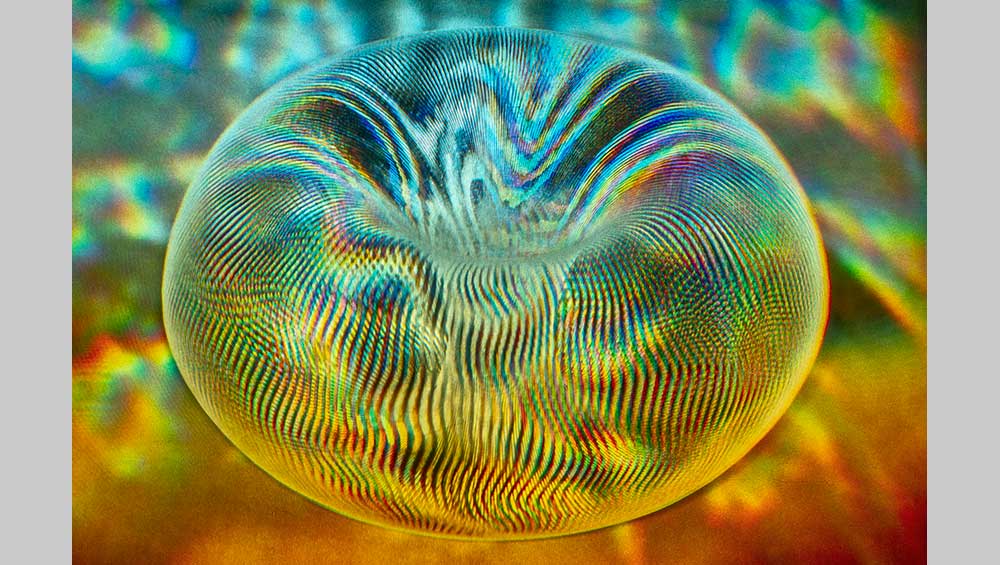
J. Paul Getty Museum, Sculpting with Light: Contemporary Artists and Holography. Deana Lawson, Torus, 2021 (exhibition copy 2023). Transmission hologram mounted to glass plate. Courtesy of the artist, Gagosian, New York, and David Kordansky Gallery, Los Angeles. © Deana Lawson. Photo: Matthew Schreiber.
Various venues, Southern California
15 September 2024 – 16 February 2025
by JILL SPALDING
Hear ye, hear ye, a great caravanserai of culture has engulfed Los Angeles! Become the largest art event in the US, largely funded by the Getty Foundation, with further support from scientific hubs such as the California Institute of Technology and Nasa’s Jet Propulsion Laboratory, this third edition of PST Art is a five-month-long sprawl of museum exhibits, gallery shows, screenings, talks, street art, performance and research-driven projects. Although themed around the “collision” of art and science (that long-accepted trope proposed by CP Snow’s The Two Cultures) many of the exhibits target collusion, with work that mediates between preservation and exploitation, craft and technology, analogue and digital, nature and machine. Here follows a rundown of Round One, October to December 2024.
Testing the ambiguity, PST ART launched in the Los Angeles Memorial Coliseum for the first 5,000 to sign up with We Are, a $20m (£15.4m) extravaganza orchestrated by the famed gunpowder artist Cai Guo-Qiang. Produced by AI and executed by drones, the closely programmed 60 minutes of pyrotechnics began in complete silence, then erupted in wild applause as Cai himself – in AI-translated English – detailed the explosions and counted down to each one: 3, 2, 1, boomboomboom! Phone-capture if you could the eye-blinding blasts of light shot from the standing rods that circled us like fire-spitting Chinese dragons, to successively pattern the sky with a rainbow of plumes, a field of flowers, a black lava flow, and the thrilling, shocking, apocalyptic climax - angry bursts of gunpowder that pounded our eardrums like canon become bombs, imprinting a harbinger of Armageddon over Cai’s intended We Are directive of Make Art Not War.
More on message, a trifecta of pull-out-the-stops exhibitions at the Getty Museum involving scientific and aesthetic applications of illumination. What is it about light, they ask, that has ever informed art? Awe, for early peoples who viewed as magic the moon’s glow, the sun’s rays, the comet’s trail and day rising from night. Mystery, for those not conversant with physics who, to this day, cannot parse a lightwave in two places at once. The innate sense, too, that we don’t fully exist until we are seen – before electricity, when lit by a candle, by the sun and, after technology enabled their production, by the light of shining materials.
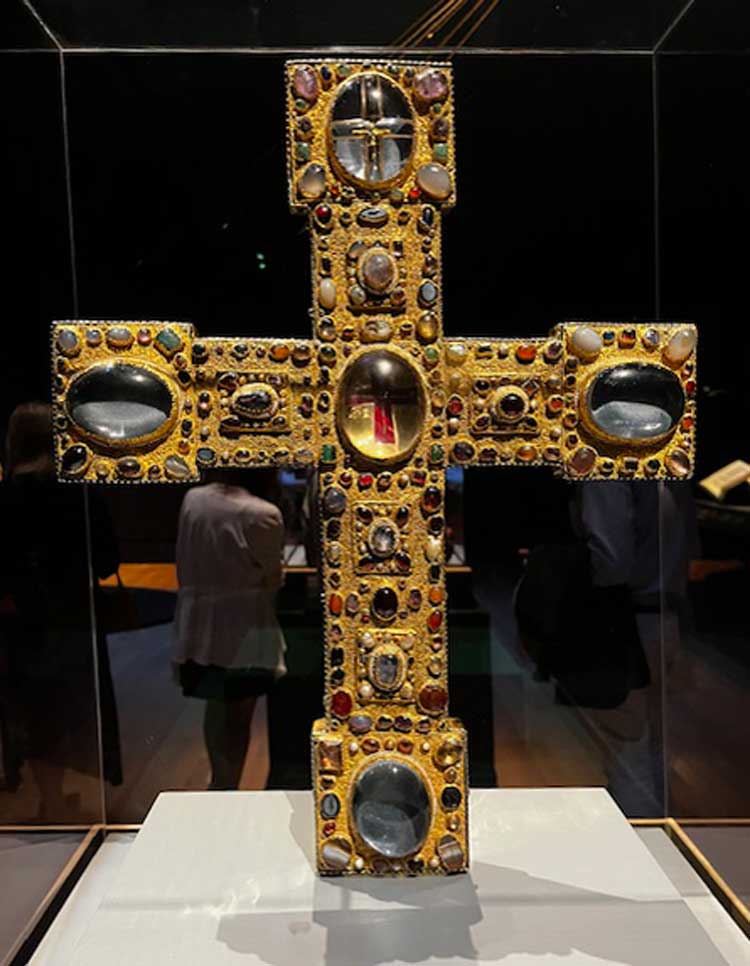
Lumen: The Art and Science of Light, installation view. Photo: Jill Spalding.
Although helpful to know the “long middle ages” (800-1600) as a time of religious and political jousting for power and souls, it’s not necessary to bone up on medieval history to be ravished by Lumen: The Art and Science of Light. A stunning display of exquisite artefacts – crosses, chalices, manuscripts, mosque lamps, glass, silver, a Byzantine chandelier and tapestries – forged, gilded, lustered, moulded, enamelled and woven with the most precious materials that illustrate the day’s highest artistry in the service of God. Alongside them, intricately fashioned precision quadrants and astrolabes testify to the era’s deep knowledge of the natural world. Curatorial genius has interspersed them with seven contemporary works - including Fred Eversley’s fastidious purple-hued parabolic lens, a mirror-smooth Anish Kapoor Vantablack sculpture and, bifurcating the darkness, E.V. Day’s seven beatific beams of light, Golden Rays/In Vitro. Commanding its own gallery, California science-trained sculptor Helen Pashgian’s 2023 Untitled (Lens), comprising multiple layers of urethane resin, creates a glowing, disorientating, blurred perspective that recalls the radiance of a Robert Irwin disc.
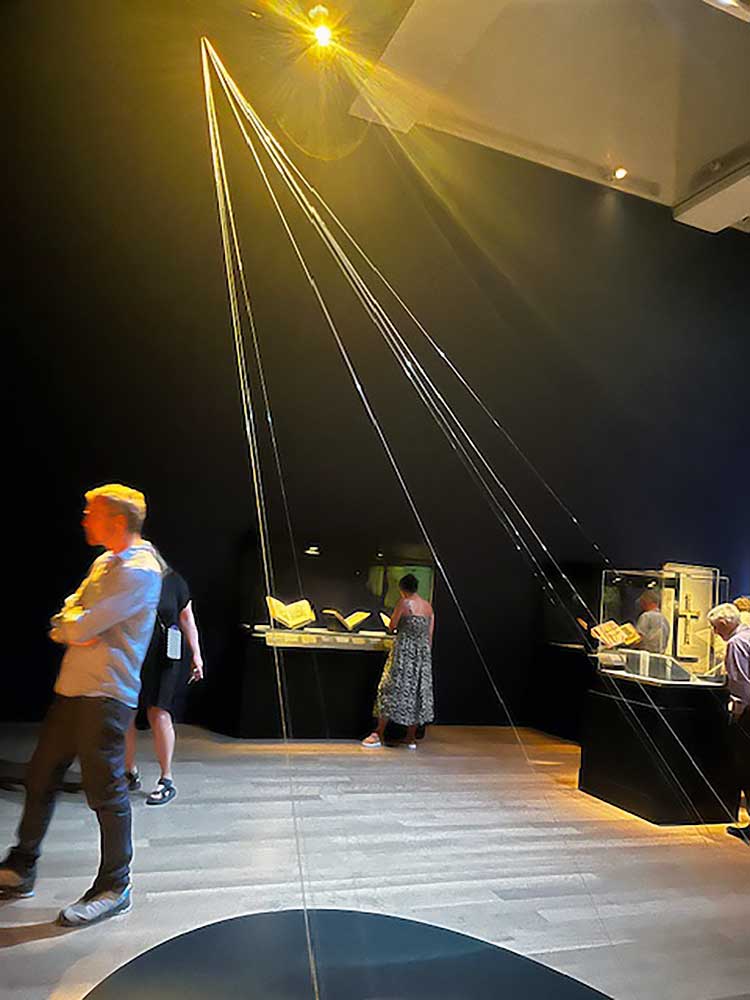
EV Day, Golden Rays / In Vitro, 2018/2024. Photo: Jill Spalding.
As steeped in the wizardry that converts light to emotion are the artists featured in Sculpting With Light: Contemporary Artists and Holography, the mind-bending art form wrought with lasers that MC Escher popularised 70 years ago. Among them, Ed Ruscha and Louise Bourgeois, whose brief attempts were followed by those of Roy Lichtenstein, Dorothea Rockburne, Chuck Close and James Turrell. The daunting exactitude required to create illusory images, seen as through glass, that disappear or transmute as you move along them, left the field to cheap efforts soon abandoned. It fell to the master technician and light artist Matthew Schreiber to elevate by their beauty an exercise in perception thought cheesy into a dazzling art form that warrants its own gallery. Controlling multiple lasers with breath-holding precision, Schreiber directed complex patterns of information to produce an image formed of light that, as one practitioner put it, “sculpts the object into being”.
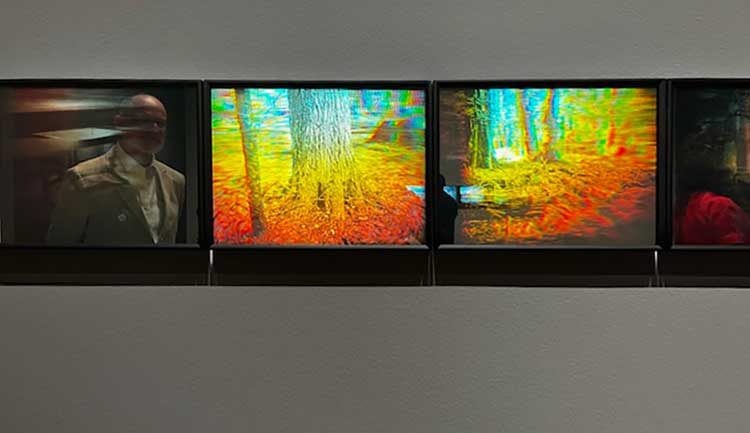
Matthew Schreiber, hologram series. Photo: Jill Spalding.
In the same pavilion, Abstracted Light: Experimental Photography, early exercises involving light as a medium by such acclaimed avant-garde photographers as Man Ray, Jaromír Funke, Tōyō Miyatake and - first to use computational power - László Moholy-Nagy, appeal as much for their eerie aesthetics as for their historical interest.
No less ambitious, Breath(e): Toward Climate and Social Justice, filling all the galleries at the Hammer Museum, features more than 20 intergenerational artists and more than 100 artworks – some monumental, several commissioned – that engage painting, sculpture, photography, software, cybernetics, AI and living organisms to address humanity’s disastrous impact on the environment. Each exhibit proposes acts of resistance, salvage, or preservation that range from succinct to extensive, from crafted to imaged, and from didactic projects charting the thawing cryosphere, toxic drift, deforestation, ocean acidification, coral-reef bleaching, water pollution, mineral extraction, biomagnification and petro-imperialism, to stirring visualisations of how climate change manifests and impacts.
Lingering in memory is a diptych by Sarah Rosalena (Exit Point, 2019) involving a neural network trained to output the combined 1972 image of Earth seen by astronauts on Apollo 17 and the M87 galaxy black hole captured in 2019 by the Event Horizon Telescope on to a mechanical Jacquard loom (held the predecessor of the computer) that is programmed to convert each pixel to a thread.
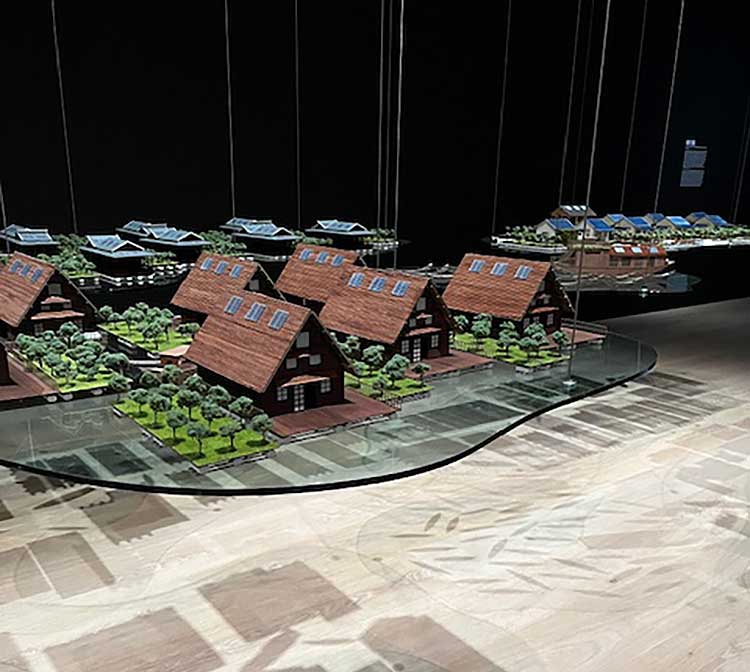
Tiffany Chung, model village. installation view, Breath(e): Toward Climate and Social Justice, Hammer Museum, Los Angeles. Photo: Jill Spalding.
Haunting, too, the sense of impending doom Tiffany Chung achieves by suspending from the ceiling her meticulously crafted large-scale model of one of the villages swallowed by the disastrous 1978 Mekong River flood that left 78,000 people homeless. Necessarily sectioned off, Garnett Puett’s “Apisculptures” brings you inside the artist’s sculpted forms to watch honeybees work them into hives.
Several exhibits play with the mind. Such is Mika Tajima’s bafflingly beautiful New Humans II (2022), a spare column topped by a black pool of rippling magnetic liquid iron programmed to “transmediate” between the visible and invisible with AI simulations of synthetic humans that endlessly form and dissolve.
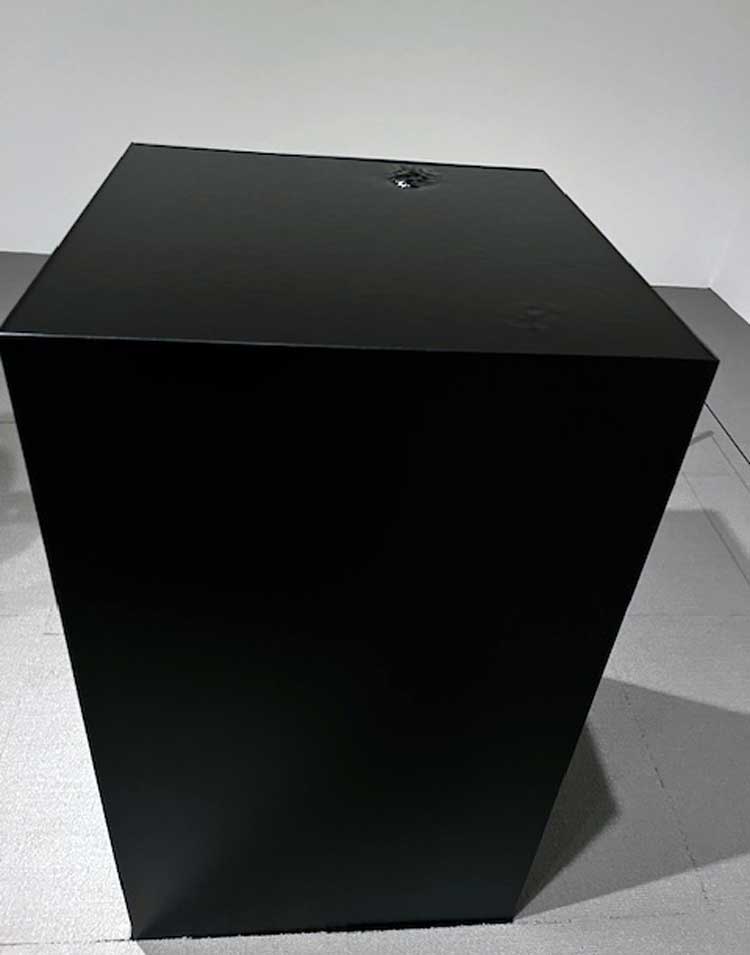
Mika Tajima. New Humans II, 2022. Photo: Jill Spalding.
Not all are successful in conveying the science/art dichotomy. Roxy Paine’s woven networks of the myriad parasitic and symbiotic fungi that sustain our woodlands are so faithfully fabricated with industrial materials as to present more like replicas than artworks. Likewise, artist and biologist Brandon Ballengée’s exemplary drawings of the marine species wiped out by the Deepwater Horizon oil spill would impress only as skilful renderings but for the caption relating that he used the crude oil as his medium. And how discern the art or the science in the environmental activist Ron Finley’s rambling assemblage – extending from the street to the entrance of two second-floor galleries – of scattered vegetation, a rusty garden gate, a scraggly bower and what-not garden elements, if you don’t read in the catalogue that it is a visual living metaphor for community collaboration involving the raw materials for breathing, and the sounds of photosynthesis created by the music collective High Seas from electric signals produced by the plants?
Less engaging are works that, though on message, don’t intrigue. Sherri Mitchell’s photograph of a melting ice flow (Penobscot River, March 2024), in contrast with Lynn Davis’s sculptural Greenland icebergs, could have as well come from the pages of National Geographic as from the hand of an artist. And Clarissa Tossin’s heat-ravaged peach tree, Rising Temperature Casualty (2022), cast in silicone, is disempowered by the memory of Robert Smithson’s brutally uprooted trees.
Least involving are research-driven projects such as that launched by Mel Chin’s activist collective IOV, which calls on artworks by people whose lives were destroyed by environmental catastrophe in the hopes of inspiring them to fight climate change and social injustice.
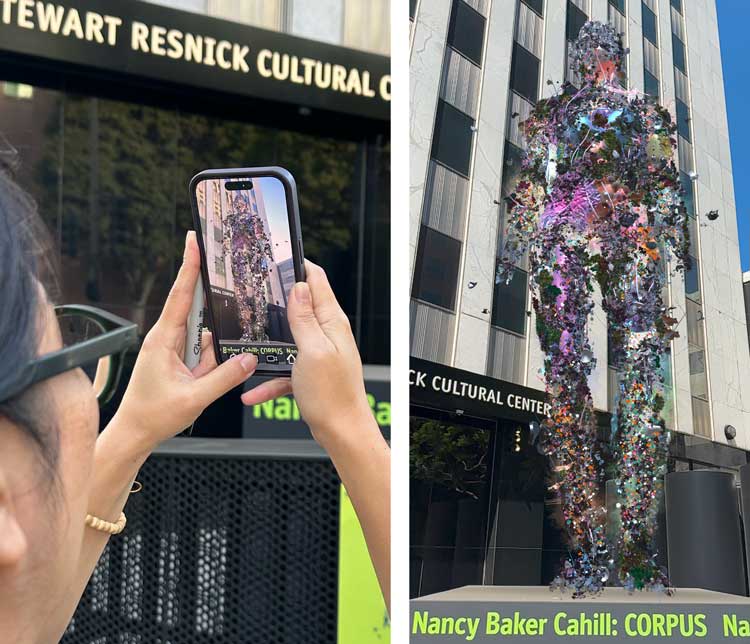
Installation view, Nancy Baker Cahill: Corpus. Hammer Museum, Los Angeles, 7 September 2024 – 2 March 2025. Photo: Courtesy of the artist.
Leave on a high. Magical though challenging (it’s viewable only on your mobile phone, at 4thwallapp.org) Nancy Baker Cahill’s Corpus (2022-2024), a monumental, glowing, dynamic, virtual statue on the Hammer’s north wall, projects the future as a “blended, embodied entanglement between human, machine, flora, lichen, microplastics and microbiome”.
Wondrous, too, at the Los Angeles Public Library (see footnote), the patented process developed by arts printer Mixografia which gives a print the same richness and illusion of texture as a painting. Deploying a coded algorithm for the same end (at the LA Louver Gallery, until 26 October), Morphosis architect Thom Mayne prints slashed wood or aluminium panels with UV ink, pigment, copper and gold leaf - layered to deliver the transparency, opacity, gleam and texture of oil paintings.
At the Rose Gallery, Alchemy in Materiality features John Chiara’s spectral photographs, each unique, formed without a negative, on colour-positive, photo-sensitive paper, by the immense custom-built camera oscura he hauls around on a trailer.
.jpg)
Light experiments for the exhibition Olafur Eliasson: OPEN at The Geffen Contemporary at MOCA, 2024. Photo: Henri Lacoste | Studio Olafur Eliasson. Courtesy of the artist; Tanya Bonakdar Gallery, New York/Los Angeles; neugerriemschneider, Berlin © 2024 Olafur Eliasson.
Open, a 20-year survey of the Icelandic-Danish artist Olafur Eliasson’s eye-bending exercises in perception (until next July, at the Geffen Contemporary at the Museum of Contemporary Art), features recent paintings and 18 monumental light installations manipulated with high-tech panache but low-tech mechanics, such as 3D Technicolor fractals, to reflect to infinity ever-morphing phenomena that include a light bulb, an amphora and you.
The Marian Goodman gallery is showing Anri Sala’s immersive video, sound and light installation, Time No Longer (2021), which floats a computer-generated image of a turntable in a space station to the unsettling sound of Olivier Messiaen’s solo for clarinet composed while a prisoner of war.
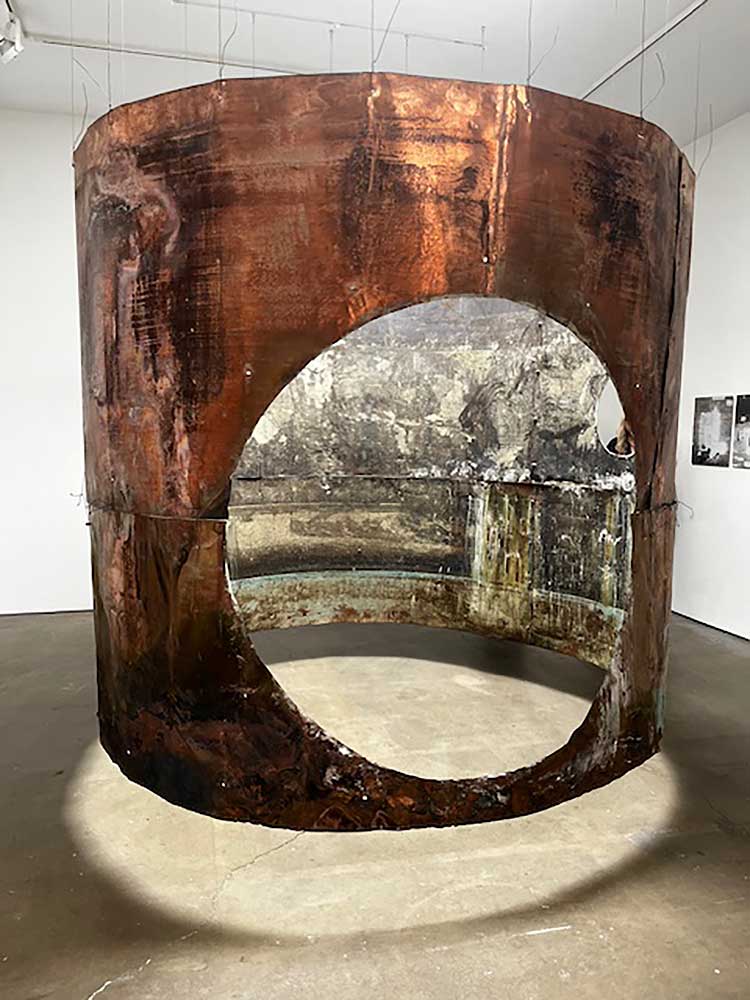
Lauren Bon. One of the copper pipes 'landscaped' by corrosive LA River water. Installation view, Concrete is Fluid, Honor Fraser Gallery. Photo: Jill Spalding.
Not to miss are life-work installations whose labour-intensive, research-exhaustive elements read as magic. First among them, Concrete is Fluid, at the Honor Fraser gallery until 14 December, documents the inordinate 12-year, $11m-and-counting project of activist land artist Lauren Bon to cleanse, conserve, redirect and repurpose critically threatened ecosystems, in particular a polluted section of the Los Angeles River that has been emptying wastewater into the sea. Standing witness, transformed to artworks possessing a strange beauty, are cement slabs from the riverbed that have been cut and layered into sculptures, landscapes etched by dumped chemicals into discarded copper tubing, sludge-coated grasses, soil sculptures and an underground kingdom of deities formed of the clay dredged from the exhausted riverbed in Bon’s heroic effort to reverse years of neglect and abuse of a water source that conditions life to one that once again will sustain it.
The “longing to know the unknowable”, as Pope.L described the practice of Korean artist Lotus L Kang, informs both site-responsive, multimedia installations in her solo show at Commonwealth and Council (until 26 October). Drawing from science fiction, feminist and decolonial theory, eastern spirituality and Chinese medicine, Kang aims to make visible the invisible by materialising identity as a web with industrial materials, cast aluminium objects, tatami mats, netting, sound, light, movement – and her signature hanging sheets of continuously morphing, light-sensitive film.
Interspersed with the magic are dutiful nods to the day’s issues – worthy exhibits that come across more as cause than as art. Such is Life on Earth: Art and Ecofeminism at the Brick (until 21 December), profiling 18 science-driven feminists who, over 40 years have produced work flagging the exploitation of natural resources, environmental racism, gender oppression, frontier masculinity and witchcraft. At the California African Museum (until next March), World Without End: the George Washington Carver Project pairs the scientist-inventor’s rural paintings with his plant samples and lab equipment to convey his twin passions for art and soil management.
Sound, deployed as a material, informs three concerts by experimental musicians Tania Candiani (Quantum Preludes, at the Getty), Claire Chase (A Day of Quantum Listening, at the Ebell), and Black Quantum Futurism (at Debs Park), who profess to demonstrate the intersection of science and music with aural meditations on such as desert biomes, nuclear research and digital sonics.
Most challenging are the exhibits addressing artificial intelligence. Highly technical, at Denenberg Fine Arts, the optical wizardry of artist Tony Gerber (in his former life a mathematician and scientist who helped develop what he prefers to call algorithmic inference) fills black glass screens with vibrating colour-saturated interplays of geometric, computer-generated designs programmed to expand, contract and dance around each other in a repetitive sequence that leaves the viewer more perplexed than engaged.
Those more comfortable with AI head to UCR Arts at UC Riverside for Digital Capture: Southern California and the Pixel-Based Image World (until next February), which presents tour-de-force imagery compiled from reams of data by such as Trevor Paglen and Refik Anadol and invites viewer interaction with obsolete software dating back to the 1960s.
So widespread are the other venues that there’s no doing it all. Radiating out like the Big Bang from Pasadena to Long Beach, Santa Barbara to San Diego, the desert to the sea, a constellation of institutional exhibitions predicated on the collusion between art and science range from enlightening to didactic.
At the Palm Springs Art Museum until next February, Particles and Waves: Southern California Abstraction and Science, 1945-1990, makes a visually arresting case for how postwar scientific research in astronomy and particle physics brought such Los Angeles artists as Mary Corse, Bettina Brendel, Helen Lundeberg, and Lee Mullican to work with light, scale and computers.
Unexpectedly moving, Wonders of Creation: Art, Science, and Innovation in the Islamic World, until January at the San Diego Museum of Art, channels the 13th-century Islamic scholar Zakariyya ibn Muhammad al-Qazwini’s influential compendium of the heavenly and earthly marvels of art and cosmography, with more than 200 wondrous objects on loan from Spain, North Africa, Kuwait and Malaysia – astrolabes, lustred glass, illuminated manuscripts, rare textiles, inscribed gems, talismans and commensurate artefacts by 12 contemporary artists – that speak to the Islamic world’s centuries-long fascination with astronomy, alchemy, natural history, medicine and mathematics. Seemingly off-point yet illustrative of the delicate balance between humanity’s action and nature’s reaction, Embodied Pacific at UC San Diego features artworks engineered with such as tule reeds by more than 30 artists working with scientists and indigenous communities.
.jpg)
LACE (Los Angeles Contemporary Exhibitions). Beatriz da Costa: (un)disciplinary tactics: PigeonBlog (2006–2008) at 13th International Symposium on Electronic Art ISEA and ZERO1 Festival in San Jose, CA, 2006, Beatriz da Costa. Courtesy of Beatriz da Costa Archive.
Although I’m reluctant to find fault with this staggering undertaking, several entries stretch the themed art/science interaction too thin. Where, for example, is the art in Beatriz da Costa: (Un)disciplinary Tactics at the Los Angeles Municipal Art Gallery, a restaging of the late artist’s two pigeon releases paired with her exercise in tactical biopolitics that empowered citizen-scientists to gather and distribute climate data to the public? So sparse is the visual material – a few drawings, two stuffed birds – that it seems to have been staged more for the performances, workshops and study groups planned around it.
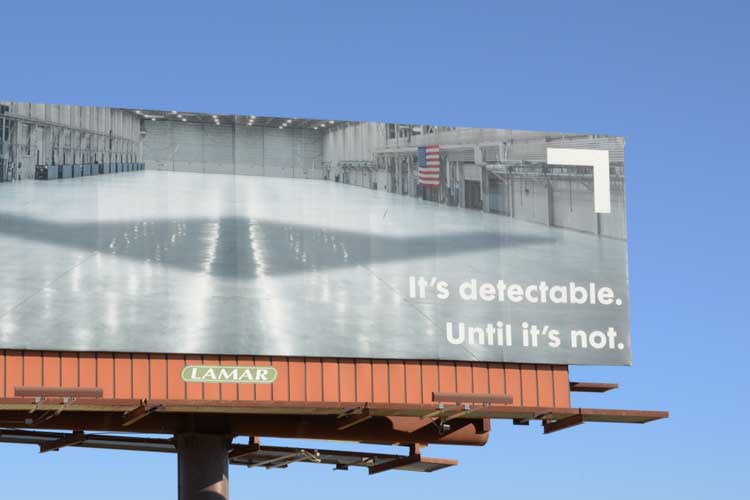
Center for Land Use Interpretation Remote Sensing: Explorations Into the Art of Detection. Billboard along Highway 14 in the Antelope Valley, north of Los Angeles, California, 2022. Digital photograph. © Copyright Center for Land Use Interpretation.
Other exhibits, though popular, are so data-driven that the art gets completely lost in the weeds. Such is Part One, at LA’s Center for Land Use Interpretation, of the Southern California Aerospace exhibition Remote Sensing: Explorations into the Art of Detection, which elaborates on the “phenomenology of remote sensing” – the development of digital tools to extract information from remotely sensed data of the Earth. (Part Two, at the Mojave Desert research station, will detail their impact on daily life, global conflict and civil liberties.)
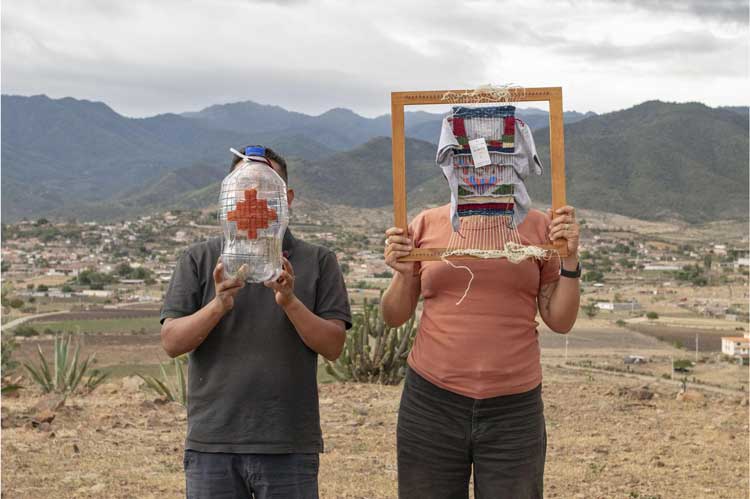
Fowler Museum at UCLA in partnership with the Museum of Contemporary Art Santa Barbara. Sangre de Nopal/Blood of the Nopal: Tanya Aguiñiga and Porfirio Gutiérrez in Conversation.
Artists Porfirio Gutiérrez and Tanya Aguiñiga hold their weavings in front of their faces on a hill near Gutiérrez’s hometown in Teotítlan del Valle, Oaxaca. Photo: Javier Lazo Gutiérrez.
Some installations are a stretch; that Sangre de Nopal, which details the significance of colour in the Indigenous Americas (at the Fowler Museum until January), attributes the discovery of cochineal to “Zapotec scientists” contradicts what is evidenced by We Live in Painting: The Nature of Color in Mesoamerican Art (at the Los Angeles County Museum of Art until September 2025); the historic wall art, textiles, pottery, sculpture and rare codices on view here – all richly dyed with extracts from minerals, metals, plants, insects and shells – relay that even the signature colours that placed Zapotec artist Porfirio Gutiérrez in the Harvard Art Museum’s Forbes Pigment Collection derive from the Indigenous world’s centuries-old cosmology of colour.
Greatest, the hyperbole linking performance to science. Such are All Watched Over by Machines of Loving Grace at the Roy and Edna Disney Calarts Theater (tickets required) ostensibly choreographed to show its potential to advance under-represented communities, and Anna Sew Hoy’s performance-involving engagements with clay modelled to “demonstrate the power found in the fleeting and handmade”. All are worthy and interesting, but performative acts of social change do not for art make.
Head spinning? Yet more wonders are promised: stay tuned for round two.
*Expressive Surfaces: Collaboration & Innovation in Printmaking (until 9 November) is an exhibition exploring the technologies and innovations developed through Mixografia’s history as a printshop. It is part of the Participating Gallery Programme for Getty’s PST Art: Art & Science Collide.